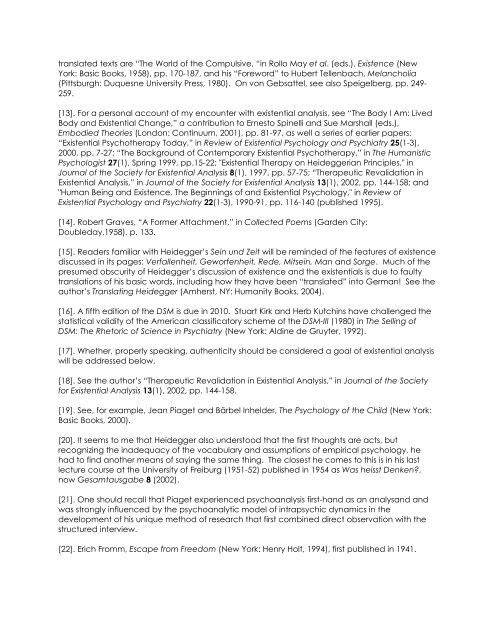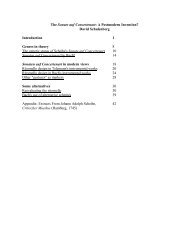SEVEN PAPERS ON EXISTENTIAL ANALYSIS ... - Wagner College
SEVEN PAPERS ON EXISTENTIAL ANALYSIS ... - Wagner College
SEVEN PAPERS ON EXISTENTIAL ANALYSIS ... - Wagner College
Create successful ePaper yourself
Turn your PDF publications into a flip-book with our unique Google optimized e-Paper software.
translated texts are “The World of the Compulsive, “in Rollo May et al. (eds.), Existence (New<br />
York: Basic Books, 1958), pp. 170-187, and his “Foreword” to Hubert Tellenbach, Melancholia<br />
(Pittsburgh: Duquesne University Press, 1980). On von Gebsattel, see also Speigelberg, pp. 249-<br />
259.<br />
[13]. For a personal account of my encounter with existential analysis, see “The Body I Am: Lived<br />
Body and Existential Change,” a contribution to Ernesto Spinelli and Sue Marshall (eds.),<br />
Embodied Theories (London: Continuum, 2001), pp. 81-97, as well a series of earlier papers:<br />
“Existential Psychotherapy Today,” in Review of Existential Psychology and Psychiatry 25(1-3),<br />
2000, pp. 7-27; “The Background of Contemporary Existential Psychotherapy,” in The Humanistic<br />
Psychologist 27(1), Spring 1999, pp.15-22; "Existential Therapy on Heideggerian Principles," in<br />
Journal of the Society for Existential Analysis 8(1), 1997, pp. 57-75; “Therapeutic Revalidation in<br />
Existential Analysis,” in Journal of the Society for Existential Analysis 13(1), 2002, pp. 144-158; and<br />
"Human Being and Existence. The Beginnings of and Existential Psychology," in Review of<br />
Existential Psychology and Psychiatry 22(1-3), 1990-91, pp. 116-140 (published 1995).<br />
[14]. Robert Graves, “A Former Attachment,” in Collected Poems (Garden City:<br />
Doubleday,1958), p. 133.<br />
[15]. Readers familiar with Heidegger’s Sein und Zeit will be reminded of the features of existence<br />
discussed in its pages: Verfallenheit, Geworfenheit, Rede, Mitsein, Man and Sorge. Much of the<br />
presumed obscurity of Heidegger’s discussion of existence and the existentials is due to faulty<br />
translations of his basic words, including how they have been “translated” into German! See the<br />
author’s Translating Heidegger (Amherst, NY: Humanity Books, 2004).<br />
[16]. A fifth edition of the DSM is due in 2010. Stuart Kirk and Herb Kutchins have challenged the<br />
statistical validity of the American classificatory scheme of the DSM-III (1980) in The Selling of<br />
DSM: The Rhetoric of Science in Psychiatry (New York: Aldine de Gruyter, 1992).<br />
[17]. Whether, properly speaking, authenticity should be considered a goal of existential analysis<br />
will be addressed below.<br />
[18]. See the author’s “Therapeutic Revalidation in Existential Analysis,” in Journal of the Society<br />
for Existential Analysis 13(1), 2002, pp. 144-158.<br />
[19]. See, for example, Jean Piaget and Bärbel Inhelder, The Psychology of the Child (New York:<br />
Basic Books, 2000).<br />
[20]. It seems to me that Heidegger also understood that the first thoughts are acts, but<br />
recognizing the inadequacy of the vocabulary and assumptions of empirical psychology, he<br />
had to find another means of saying the same thing. The closest he comes to this is in his last<br />
lecture course at the University of Freiburg (1951-52) published in 1954 as Was heisst Denken?,<br />
now Gesamtausgabe 8 (2002).<br />
[21]. One should recall that Piaget experienced psychoanalysis first-hand as an analysand and<br />
was strongly influenced by the psychoanalytic model of intrapsychic dynamics in the<br />
development of his unique method of research that first combined direct observation with the<br />
structured interview.<br />
[22]. Erich Fromm, Escape from Freedom (New York: Henry Holt, 1994), first published in 1941.















